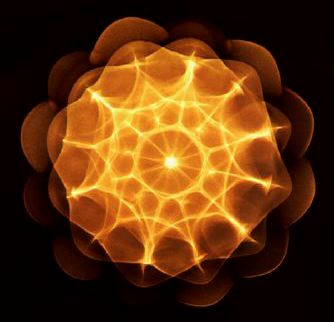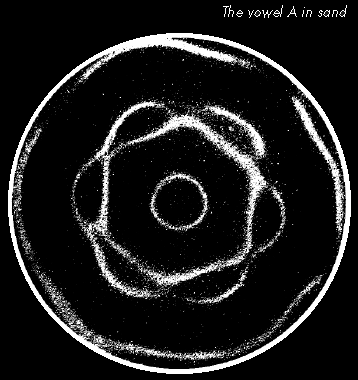 --| LOGOS & CRYSTALIZED AIR |---
As I speak to you, you hear my words.
Thus, you hear my thoughts,
which existed initially in my soul
and which I could conceal from you
if I did not transform them into words.
I transform these thoughts into sounds.
If there were no air between you and me,
you would not hear my words,
but as soon as I begin speaking,
the air in this space moves.
Each time I say a word, I induce a specific state of vibration in this space.
The whole body of air vibrates in ways that correspond to how my words are pronounced.
Let us now take this thought further.
Imagine that we can transform air into a liquid and then into a solid.
Already today, it is possible to solidify air. You know that steam,
the gaseous form of water, liquefies when it cools and is transformed
into solid ice when it freezes.
Now imagine that I pronounce the word 'god' in the air-filled space.
If you could solidify the air at the very instant these sound waves
are present, a shape -- perhaps a shell-like shape, for example --
would fall to earth.
The word 'world' would produce a different shape. You would be able
to capture my words, and each word would correspond to a shape made
out of crystalized air.
--| LOGOS & CRYSTALIZED AIR |---
As I speak to you, you hear my words.
Thus, you hear my thoughts,
which existed initially in my soul
and which I could conceal from you
if I did not transform them into words.
I transform these thoughts into sounds.
If there were no air between you and me,
you would not hear my words,
but as soon as I begin speaking,
the air in this space moves.
Each time I say a word, I induce a specific state of vibration in this space.
The whole body of air vibrates in ways that correspond to how my words are pronounced.
Let us now take this thought further.
Imagine that we can transform air into a liquid and then into a solid.
Already today, it is possible to solidify air. You know that steam,
the gaseous form of water, liquefies when it cools and is transformed
into solid ice when it freezes.
Now imagine that I pronounce the word 'god' in the air-filled space.
If you could solidify the air at the very instant these sound waves
are present, a shape -- perhaps a shell-like shape, for example --
would fall to earth.
The word 'world' would produce a different shape. You would be able
to capture my words, and each word would correspond to a shape made
out of crystalized air.
 ...Christians imagined that the creation of the universe began
with thoughts of things, which were then pronounced by the divinity
and sent forth into space. The plants and minerals you see are divine
words that have solidified. You can imagine that they were once dissolved
in the sound vibrations of the divine cosmic word. Each thing we see--so said
the early Christians--is a divine word become solid.
Therefore they distinguished between the Father, who remains hidden and has
not yet expressed himself, the Son or Word that resounds through space, and
the solidified word, or Revelation. In this way we can understand the deeper
meaning of the beginning of the Gospel According to John:
'In the beginning was the Word,
and the Word was with God,
and a God was the Word.
The Word was with God at the beginning,
and through it all things came to be;
no single thing was created without it.'
Everything that came into existence emerged from the Word.
When we take these statements as literally as possible, it is easy to
acknowledge the creative power of the Word or logos. LOGOS must not be translated
as anything except word, because this passage means that the unspoken creative
word underlies all external creation. The resounding word is the source of everything
that exists. If we went back through the ages, we would hear all the objects and
beings we now know as animals, plants, minerals, and humans resounding through
cosmic space, just as you hear my words today, because the air had not yet cooled
enough for them to precipitate as solid forms.
(Rudolf Steiner, Rosicrucian Practice, June 28, 1907, Kassel, pp. 61-62)
--| String Theory - The Music of the Microscopic Spheres |---
What is string theory? How does it differ from previous theories?
And what holes in other theories does it mend?
The basic idea of string theory is pretty straightforward. It tries to
answer a question that has been asked for two-and-a-half thousand years,
which is, What are the smallest ingredients making up everything in the
world around us? So, to be more specific, if you take a block of wood, cut
that block of wood in half, cut the remaining piece in half again and keep
on slicing the remaining piece into ever-smaller chunks of wood, where
does the cutting stop? What is the finest, uncuttable ingredient that you
get to?
Now, in our age, we know that sooner or later in this cutting process,
you'll get to atoms. But we know that atoms are not the end of the line,
because they can be split, they can be cut up into finer ingredients—
little electrons that orbit around the central nucleus, which itself
is made up of smaller particles, neutrons and protons. And even
those particles, we learned in the late sixties, are made of finer
ingredients known as quarks. It's sort of like a sequence of Russian
dolls. Prior to string theory, it stopped with electrons and quarks.
There was nothing finer. You couldn't find anything within them.
String theory comes along and challenges that idea. It says that inside
an electron, inside a quark, inside any particle that you've ever heard of,
there is something else. It's a little filament, a little filament of
vibrating energy. It kind of looks like a tiny, tiny vibrating string,
which is why we call the theory 'string theory'. The wonderful idea is
that in the same way the string on a violin can vibrate in different
patterns, which our ears would hear as different musical notes, these
little strings in string theory also can vibrate in different patterns.
They don't produce different notes, however; they produce the different
particles. So an electron is the string vibrating one way. A quark would
be a string vibrating a different way. It's kind of like a music of the
spheres injected into the microscopic makeup of the universe. That's the
basic idea of the theory.
(Brian Greene, the author of The Fabric of the Cosmos,
The Universe Made Simple, The Atlantic Monthly, May 20, 2004)
--| References |---
- Cymatics
http://www.alphaomega.se/english/cymatics.html
- Tolkien's Ainulindale - Music of the Ainir
http://home.earthlink.net/~johnrpenner/Articles/Ainulindale.html
- Bridge-Body-Tone (Music Sound Silencio)
http://home.earthlink.net/~johnrpenner/Articles/BridgeBodyTone.html
- The Golden Proportion
http://home.earthlink.net/~johnrpenner/Articles/GoldenLogos.html
---
...Christians imagined that the creation of the universe began
with thoughts of things, which were then pronounced by the divinity
and sent forth into space. The plants and minerals you see are divine
words that have solidified. You can imagine that they were once dissolved
in the sound vibrations of the divine cosmic word. Each thing we see--so said
the early Christians--is a divine word become solid.
Therefore they distinguished between the Father, who remains hidden and has
not yet expressed himself, the Son or Word that resounds through space, and
the solidified word, or Revelation. In this way we can understand the deeper
meaning of the beginning of the Gospel According to John:
'In the beginning was the Word,
and the Word was with God,
and a God was the Word.
The Word was with God at the beginning,
and through it all things came to be;
no single thing was created without it.'
Everything that came into existence emerged from the Word.
When we take these statements as literally as possible, it is easy to
acknowledge the creative power of the Word or logos. LOGOS must not be translated
as anything except word, because this passage means that the unspoken creative
word underlies all external creation. The resounding word is the source of everything
that exists. If we went back through the ages, we would hear all the objects and
beings we now know as animals, plants, minerals, and humans resounding through
cosmic space, just as you hear my words today, because the air had not yet cooled
enough for them to precipitate as solid forms.
(Rudolf Steiner, Rosicrucian Practice, June 28, 1907, Kassel, pp. 61-62)
--| String Theory - The Music of the Microscopic Spheres |---
What is string theory? How does it differ from previous theories?
And what holes in other theories does it mend?
The basic idea of string theory is pretty straightforward. It tries to
answer a question that has been asked for two-and-a-half thousand years,
which is, What are the smallest ingredients making up everything in the
world around us? So, to be more specific, if you take a block of wood, cut
that block of wood in half, cut the remaining piece in half again and keep
on slicing the remaining piece into ever-smaller chunks of wood, where
does the cutting stop? What is the finest, uncuttable ingredient that you
get to?
Now, in our age, we know that sooner or later in this cutting process,
you'll get to atoms. But we know that atoms are not the end of the line,
because they can be split, they can be cut up into finer ingredients—
little electrons that orbit around the central nucleus, which itself
is made up of smaller particles, neutrons and protons. And even
those particles, we learned in the late sixties, are made of finer
ingredients known as quarks. It's sort of like a sequence of Russian
dolls. Prior to string theory, it stopped with electrons and quarks.
There was nothing finer. You couldn't find anything within them.
String theory comes along and challenges that idea. It says that inside
an electron, inside a quark, inside any particle that you've ever heard of,
there is something else. It's a little filament, a little filament of
vibrating energy. It kind of looks like a tiny, tiny vibrating string,
which is why we call the theory 'string theory'. The wonderful idea is
that in the same way the string on a violin can vibrate in different
patterns, which our ears would hear as different musical notes, these
little strings in string theory also can vibrate in different patterns.
They don't produce different notes, however; they produce the different
particles. So an electron is the string vibrating one way. A quark would
be a string vibrating a different way. It's kind of like a music of the
spheres injected into the microscopic makeup of the universe. That's the
basic idea of the theory.
(Brian Greene, the author of The Fabric of the Cosmos,
The Universe Made Simple, The Atlantic Monthly, May 20, 2004)
--| References |---
- Cymatics
http://www.alphaomega.se/english/cymatics.html
- Tolkien's Ainulindale - Music of the Ainir
http://home.earthlink.net/~johnrpenner/Articles/Ainulindale.html
- Bridge-Body-Tone (Music Sound Silencio)
http://home.earthlink.net/~johnrpenner/Articles/BridgeBodyTone.html
- The Golden Proportion
http://home.earthlink.net/~johnrpenner/Articles/GoldenLogos.html
---
|

